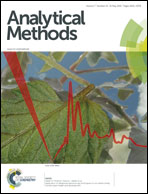A fluorescence polarization immunoassay method for detection of the bisphenol A residue in environmental water samples based on a monoclonal antibody and 4′-(aminomethyl)fluorescein
Abstract
Based on a sensitive monoclonal antibody against bisphenol A (BPA) and a new tracer named BVA–AMF, a homogeneous fluorescence polarization immunoassay (FPIA) was developed and applied in the determination of bisphenol A in environmental water samples. BVA was selected as the hapten to couple with bovine serum albumin and the conjugate was used as the immunogen for the monoclonal antibody production. Three fluorescein-labeled BVA tracers with different structures (BVA–AMF, BVA–EDF, and BVA–lysFITC) were synthesized. Under the same optimal conditions, BVA–AMF showed the highest sensitivity for FPIA and the detection of BPA exhibited a limit of detection of 5.60 ng mL−1, an IC50 of 140 ng mL−1 and a dynamic range of 11.32–904.21 ng mL−1 approximately. In this assay, several similar compounds were shown of little significantly with the cross-reactivity being less than 0.15%. Four different kinds of water samples were analyzed, with recoveries being 87.91–114.28%. The detection standard curve of BPA exhibited a good linearity (R2 = 0.9913, n = 3). Compared with ELISA and HPLC methods, FPIA showed reliability and a high correlation with ELISA of 0.9964 and HPLC of 0.9971. The proposed immunoassay technique is suitable for detection of BPA in authentic environmental water samples.


 Please wait while we load your content...
Please wait while we load your content...